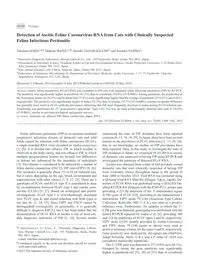
2013 Detection of Ascitic Feline Coronavirus RNA from Cats with Clinically Suspected Feline Infectious Peritonitis PDF
Preview 2013 Detection of Ascitic Feline Coronavirus RNA from Cats with Clinically Suspected Feline Infectious Peritonitis
NOTE Virology Detection of Ascitic Feline Coronavirus RNA from Cats with Clinically Suspected Feline Infectious Peritonitis Takehisa SOMA1)*#, Makoto WADA2,3)#, Satoshi TAHARAGUCHI4) and Tomoko TAJIMA2) 1)Veterinary Diagnostic Laboratory, Marupi Lifetech Co., Ltd., 103 Fushiocho, Ikeda, Osaka 563–0011, Japan 2)Department of Veterinary Science, Graduate School of Life and Environmental Sciences, Osaka Prefecture University, 1–58 Rinku-Orai- Kita, Izumisano, Osaka 598–8531, Japan 3)Tani Animal Hospital, 240–8 Hirai, Naka-ku, Sakai, Osaka 599–8251, Japan 4)Laboratory of Veterinary Microbiology II, Department of Veterinary Medicine, Azabu University, 1–17–71 Fuchinobe, Chuo-ku, Sagamihara, Kanagawa 252–5201, Japan (Received 21 February 2013/Accepted 15 May 2013/Published online in J-STAGE 29 May 2013) ABSTRACT. Ascitic feline coronavirus (FCoV) RNA was examined in 854 cats with suspected feline infectious peritonitis (FIP) by RT-PCR. The positivity was significantly higher in purebreds (62.2%) than in crossbreds (34.8%) (P<0.0001). Among purebreds, the positivities in the Norwegian forest cat (92.3%) and Scottish fold (77.6%) were significantly higher than the average of purebreds (P=0.0274 and 0.0251, respectively). The positivity was significantly higher in males (51.5%) than in females (35.7%) (P<0.0001), whereas no gender difference has generally been noted in FCoV antibody prevalence, indicating that FIP more frequently develops in males among FCoV-infected cats. Genotyping was performed for 377 gene-positive specimens. Type I (83.3%) was far more predominantly detected than type II (10.6%) (P<0.0001), similar to previous serological and genetic surveys. KEY WORDS: domestic cat, effusive FIP, feline coronavirus, Japan, RNA. doi: 10.1292/jvms.13-0094; J. Vet. Med. Sci. 75(10): 1389–1392, 2013 Feline infectious peritonitis (FIP) is an immune-mediated progressive infectious disease of domestic cats and wild felids caused by infection with feline coronavirus (FCoV), a single-stranded RNA virus classified as Alphacoronavirus [1, 28]. It is divided into effusive FIP, in which exudate is observed in the body cavity, and non-effusive FIP, in which multiple pyogranuloma lesions are formed, but differences in lesions are influenced by the immunity of individuals [3]. This disease is considered to be induced by a mutant of feline enteric coronavirus (FECV), FIP virus (FIPV) [8, 26]. The incidence is generally about 1% in FCoV-infected cats, but it varies depending on the age, breed, environment and superinfection with other viruses [7, 8, 17, 23]. There are 2 genotypes of FCoV, and FCoV type II is considered to arise by recombination between FCoV type I and canine coro- navirus (CCoV) [9, 27]. Based on serological and genetic investigations, FCoV type I is overwhelmingly dominant over FCoV type II, and mixed infection with both types is not rare [6, 11, 14, 15]. Since FIPV and FECV cannot be distinguished serologically or genetically, it is generally difficult to diagnose FIP [1], but it has been stated that the demonstration of FCoV RNA in ascites is one of most reli- able diagnostic indicators of FIP [3, 10]. Several results concerning the state of FIP incidence have been reported overseas [6, 15, 16, 18, 29]. In Japan, there have been several reports on the prevalence of FCoV infection [11, 13, 20, 24], but, to our knowledge, no studies on FIP prevalence have been reported. Thus, in this study, to investigate the state of FIP incidence in Japan, we examined FCoV RNA in ascites of domestic cats suspected of having FIP using RT-PCR and investigated the genotype of detected FCoV RNA. Ascites was obtained from a total of 854 privately owned domestic cats that were clinically suspected of having FIP from veterinary clinics throughout Japan in the period of June 2008 to October 2012. Viral RNA was extracted using a QIAamp Viral RNA Mini Kit (Qiagen, Tokyo, Japan). De- tection of FCoV RNA was performed using a QIAGEN On- eStep RT-PCR Kit (Qiagen) with the P205-P211 primer pair providing a 223 bp amplicon of the 3’-untranslated region (UTR) gene of FCoV [10], according to the manufacturer’s instructions. FIPV strain 79-1146 (American Type Culture Collection, Rockville, MD, U.S.A.) was used as a positive reference virus. Furthermore, for samples in which the 3’- UTR gene was detected, genotyping was performed with the nested RT-PCR reported by Addie et al. [4], providing 360 and 218 bp amplicons of FCoV types I and II, respectively. FIPV strain UCD1 (kindly provided by Azabu University) and FIPV strain 79-1146 (same as above) were used as positive reference viruses for the types I and II, respectively. Gene positivity was analyzed by chi-square test (StatView, Adept Scientific, Herts, U.K.), and a P value of <0.05 was considered statistically significant. The 3’-UTR gene was detected in 377 of 854 cats (44.1%). Grouped by breed, the gene positivity was significantly higher in purebreds (62.2%; 181 of 291) than in crossbreds *CorrespondenCe to: Soma, T., Veterinary Diagnostic Labora- tory, Marupi Lifetech Co., Ltd., 103 Fushiocho, Ikeda, Osaka 563–0011, Japan. e-mail:
